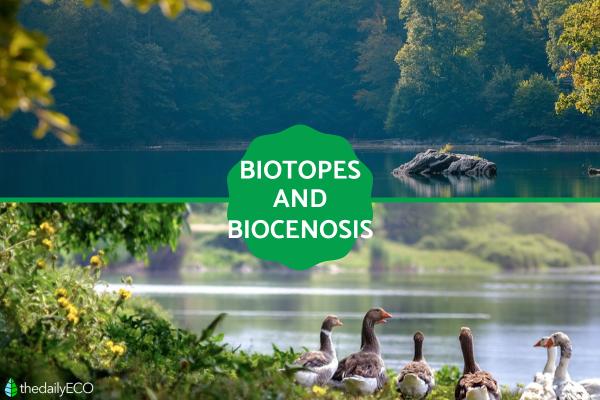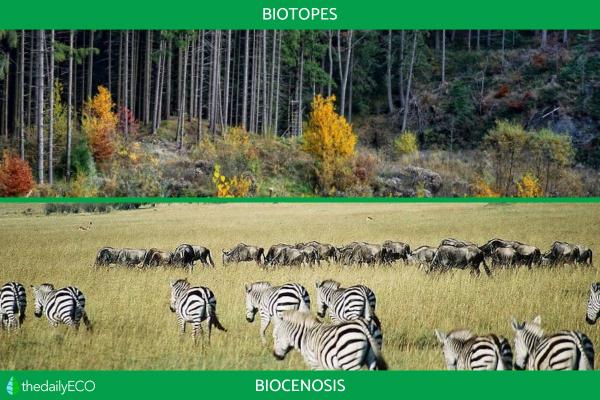
Ecology is the study of ecosystems and the various biological, zoological, botanic and environmental processes which construct these ecosystems. One definition of ecosystems states they are formed by natural environments called biotopes and by a community of living beings called biocenosis. These can be confusing terms for those not well acquainted with ecological terminology, but understanding biotopes and biocenosis can help us to have a greater understanding of how ecosystems work.
At thedailyECO, we provide definitions of biotopes and biocenosis so you can gain this better understanding. We also look at the differences between biotopes and biocenosis, as well as examples of how they occur in nature.
Definition of biotope and characteristics
When we compare biotope and biocenosis, we are discussing different constituent parts of an ecosystem. Specifically, a biotope is:
An area of environmental space made up of the non-living parts that form an ecosystem.
In this sense, the biotope refers to the physical space in which the living beings of an ecosystem can exist. These living beings are the plants, animals and other organisms which make up an ecosystem.
The territory of a biotope is also made up of physical-chemical environmental factors. These include:
- Temperature
- Amount of sunlight (UV rays especially)
- pH of water
- Salinity of water
- Types of rock
- Levels and type of soil nutrition
Many people use the term biotope interchangeably with the habitat. In many ways, they are very similar, but some researchers distinguish the terms thanks to biocenosis, which we explain below.
Learn more about the different types of ecosystems with our related article.

Biocenosis definition and characteristics
Although the two terms are linked, where biotope relates to the non-living aspects of an ecosystem, biocenosis is concerned with how the living aspects of an ecosystem interact. Specifically, the definition of biocenosis is:
How the organisms within an ecosystem interact when living together in a biotope or habitat.
The constituent parts of a biocenosis are living organisms which include animals, plants and microorganisms. Although the term is applicable, many researchers do not use biocenosis. Instead, they often refer to biocenosis as:
- Biological community
- Biotic community
- Ecological community
- Biocenose
These terms can be helpful in various ways. One important way is that they highlight the fact that organisms living in a collective, i.e. a community. Nothing lives in a completely isolated bubble. It is all interlinked with other organisms, non-living objects and the processes which occur due to the continuance of life.
We investigate more about how living things are organized with our article on the difference between biomes and ecosystems.
Difference between biotopes and biocenosis
The main difference between both concepts is that the biotope is the abiotic part of an ecosystem. This means it refers to its physical and geographical space which has certain environmental and climatic characteristics. The physical elements that are detected in the biotope include water, air and the substrate. The physical-chemical elements that form ecosystems include solar radiation, temperature, humidity or pH level. The biocenosis is the biotic part and is formed by all those existing life forms of plants, animals, microorganisms and other living beings.
Even within biotic and abiotic elements, we can see great diversity. Learn more with our article on the difference between plant and animals cells.

Relationship between biotope and biocenosis
Between the biotope and biocenosis is an intrinsic interrelation which involves and exchange of energy and matter. In order for life to be possible (i.e. for biocenosis to develop), it is important that the appropriate environmental conditions exist in the biotope.
Depending on the environmental conditions of a given area, the species and biological communities that exist are different. Each territory contains different organisms that are adapted to existing in theses specific environmental conditions. For example, organisms in an aquatic ecosystem may have adaptations such as gills and fins to allow them to survive underwater. Or species in a desert ecosystem area are adapted to withstand solar radiation and high temperatures.
For this reason, we can find different types of biotopes with different forms of biocenosis within them. For example, we can find lake biological communities, savannah biological communities, forest biological communities and more. Find out the difference between two such biotopes with our article on the difference between lakes and lagoons.
There is not only an interrelation between biotope and biocenosis, but also between the communities of the ecosystems themselves. There may be two types of relationships:
- Intraspecific: when there are relationships between organisms of the same species. There is intraspecific competition and grouping (colonies, families, gregariousness or societies).
- Interspecific: the interrelation between organisms of different species. In these interactions, there are various types of interaction. Some where species benefit from that interaction (mutualism, symbiosis), some where one species is harmed and another benefited (commensalism, amensalism, parasitism and predation) and even some where both species are harmed (competition).
It is also important to highlight trophic relationships, since these are relationships that occur between organisms in various ecosystems.
Examples of biotopes
Broadly speaking, biotopes can be classified into three groups. Within these groups are various different subtypes. The main types of biotope are:
- Terrestrial biotope: within a terrestrial biotope we find those biotopes formed by mountains, forests, meadows, savannahs and deserts, among others.
- Aquatic biotope: aquatic biotopes include oceans, seas, rivers, lakes and lagoons.
- Mixed biotope: these are a combination of both terrestrial and aquatic biotopes, among which we can highlight wetlands or coastal regions.

Examples of biocenosis
The set of living beings that make up the biocenosis is very broad and diverse, dividing it into three main types:
- Phytocoenosis: group living organisms formed by plant species such as species of trees, herbaceous, algae, among others.
- Zoocenosis: group of living beings that is made up of animal species, such as mammals, birds, reptiles, fish, insects, etc.
- Microbiocenosis: all types of existing microorganisms, which are those living beings that cannot be seen with the naked eye, and the use of a microscope is necessary. Some examples are prokaryotic unicellular organisms such as bacteria, or eukaryotic organisms such as protozoa.
Learn more about the different types of biotopes and biocenosis with our article on natural regions.
If you want to read similar articles to Biotopes and Biocenosis - Definition and Differences, we recommend you visit our Ecosystems category.